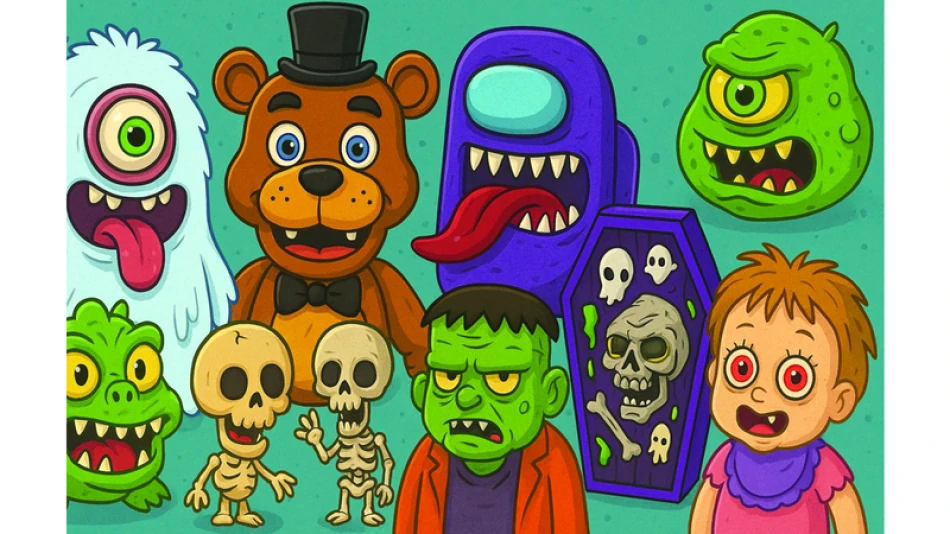
Popular 'Trend' Games Trigger Childhood Fears and Emotional Distress
UAE Parents Sound Alarm Over Disturbing Children's Toys Flooding Local Markets
A growing wave of horror-themed and psychologically disturbing toys is infiltrating UAE toy stores, prompting parents to raise serious concerns about their children's mental health and behavioral development. From toilet-themed singing characters to games promoting violence and elimination tactics, these products—often inspired by viral social media content—are capturing children's attention during school holidays when playtime peaks. Child psychologists warn that prolonged exposure could trigger sleep disorders, anxiety, and aggressive behavior, particularly in younger children who struggle to distinguish fantasy from reality.
The New Generation of Disturbing Play
Ahmed Al Muhiri, a concerned father, described encountering games that center around eliminating characters within groups through various violent methods. "These toys plant seeds of violence and anxiety in children who enjoy them without understanding their psychological impact," he explained to local media.
The contrast with previous generations is stark. Traditional childhood toys were simple, age-appropriate, and free from violent or frightening imagery that could cause distress. Today's landscape presents a fundamentally different challenge, with toys that actively feed fear and create psychological obstacles for developing minds.
Social Media's Influence on Toy Design
Market surveys reveal that many of these problematic toys draw direct inspiration from viral horror content circulating on social media platforms. This represents a concerning trend where adult-oriented digital content is being repackaged as children's entertainment, often without adequate age verification or psychological impact assessment.
Mother Alya Al Shahi encountered one particularly disturbing example: a toilet-shaped toy featuring a singing, swaying human head. "I felt disgusted by the concept and wondered anxiously: where have we ended up with our children?" she reflected.
Behavioral Changes Parents Are Witnessing
The psychological impact extends beyond mere discomfort. Maha Al Maroushad purchased what she assumed was an innocent, entertaining toy for her child, only to observe significant behavioral changes afterward.
"After playing, he would use strange words and experience fear at bedtime," she reported. This pattern of delayed psychological effects appears common, with symptoms sometimes emerging days or weeks after initial exposure.
The Regulatory Gap
Parents are calling for shared responsibility among families, retailers, and regulatory authorities to control the spread of psychologically harmful toys. However, the primary burden currently falls on parents to maintain constant vigilance over their children's entertainment choices.
Alya Ahli emphasized that monitoring children requires enormous patience and continuous oversight, particularly given the proliferation of toys with negative psychological themes. The challenge intensifies during school holidays when children have extended periods for play and exploration.
Expert Analysis: When Fear Becomes Harmful
Understanding Normal vs. Problematic Fear
Dr. Maha Al Ali, a child and adolescent psychiatrist, explains that some fears are natural parts of childhood development. Young children typically fear loud sounds or darkness, while older children develop anxieties related to school or social relationships.
However, repeated exposure to age-inappropriate horror toys can push children beyond these natural developmental fears, potentially causing regression in behavioral and psychological growth. Symptoms may include involuntary urination, fear of sleeping alone, or unhealthy attachment to frightening characters—indicators that may require professional psychological evaluation.
Age-Dependent Impact Levels
The psychological effects vary significantly by age group. Teenagers might be drawn to scary content through curiosity and thrill-seeking behavior, but excessive exposure can lead to decreased sensitivity toward violence. Younger children experience deeper, more lasting impacts, including sleep disorders, anxiety, and recurring nightmares.
Dr. Muath Al Zarouni, a psychiatric consultant, notes that appropriateness isn't simply a yes-or-no question but depends on the child's individual nature, circumstances, and how the toy is presented. Children aged 12 and above generally possess better ability to distinguish between fantasy and reality, making them somewhat more resilient to scary content.
The Path Forward: Balanced Supervision
Strategic Parental Engagement
Effective oversight doesn't require complete prohibition but rather active presence in children's play and digital lives. Parents should engage in selection processes, provide explanations, and help children understand what they're experiencing.
Dr. Al Zarouni recommends asking simple questions after play sessions: "How did you feel when you played this game? What scared you most? What did you like most?" This approach creates safe spaces for expression while helping parents detect early warning signs of anxiety or distress.
Recognizing Delayed Effects
Psychological impacts may not appear immediately but can manifest days or weeks later. Parents should monitor changes in behavior, sleep patterns, social relationships, and general mood. The goal extends beyond mere supervision to include psychological and educational accompaniment as children navigate both digital and imaginative worlds.
Providing Positive Alternatives
Rather than simply restricting problematic toys, parents should offer engaging, safe alternatives such as intelligence games, group activities, or interactive stories. This approach helps children understand that oversight directs them toward better choices rather than simply limiting their options.
When concerning behavioral or emotional changes persist, professional psychological consultation becomes essential, as children may lack the vocabulary to express their feelings except through behavioral changes.
Most Viewed News

 Sara Khaled
Sara Khaled






